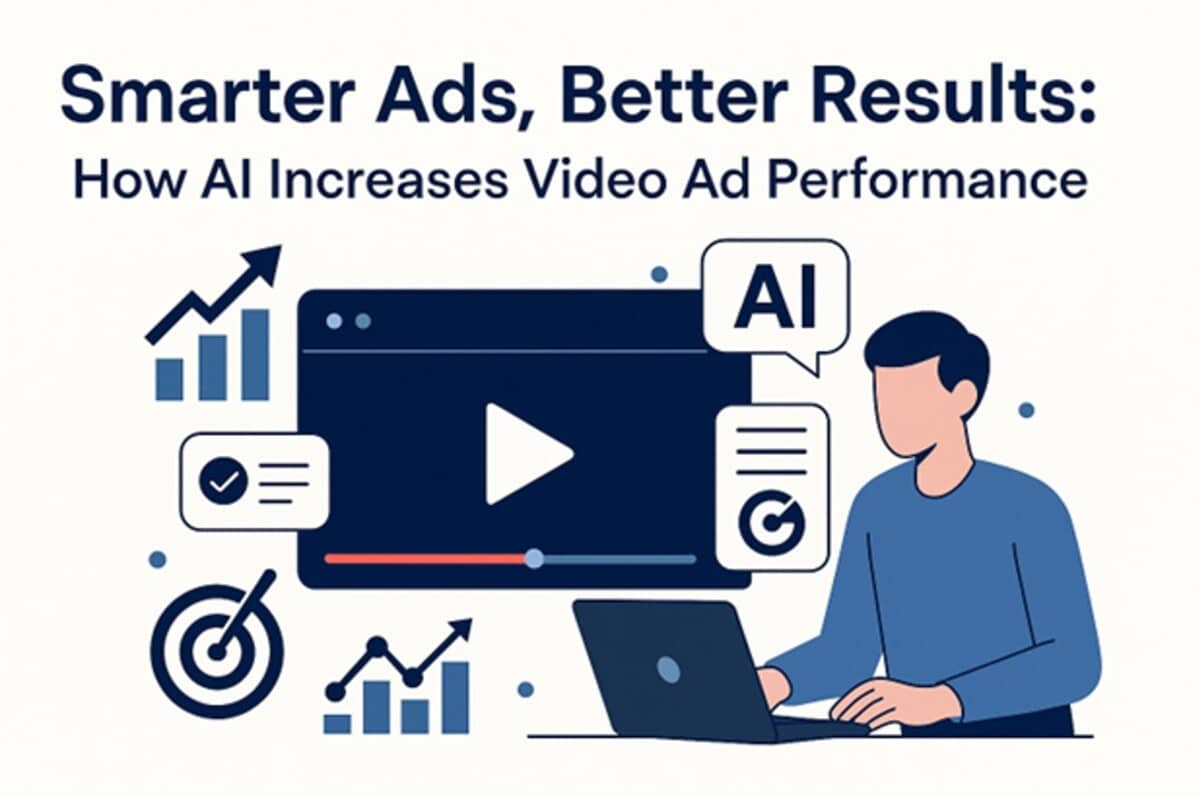In a media environment where consumers scroll, skip, or outright ignore traditional advertising, video ads have emerged as one of the most powerful channels for marketers who want true engagement and measurable results. While the format is compelling on its own, the addition of machine-guided intelligence — analyzing behaviour, optimizing content, and automating decisions — has taken video ad performance to a new level. This article explains how AI video ads work, why they matter, and how you can adapt your approach to yield stronger outcomes.
Performance metrics you need to know
Video ads aren’t just about getting seen; they’re about converting attention into action. The most valuable metrics to track include:
- Completion rate: how many viewers watch to the end.
- View-through rate: how many take an intended action after watching.
- Click-through rate (CTR): usually between 1–3% for digital ads.
- Cost per action (CPA): how efficiently you’re converting viewers.
Without clear benchmarks and regular testing, brands can’t gauge effectiveness or identify what drives results.
What’s changing
Audiences expect relevance, seamless experiences, and short attention spans. The one-size-fits-all “TV spot” approach doesn’t work online. To thrive, advertisers must personalise content, adapt to different devices, and make smarter decisions about targeting, placement, and format.
How AI improves video ad performance
Smarter targeting and segmentation
Intelligent systems can identify who is most likely to engage or convert by analysing behavioural data, purchase intent, and contextual signals. Predictive modelling refines audience segments by demographics, interests, and timing, allowing you to serve ads only when viewers are most receptive. This means fewer wasted impressions and a greater chance of meaningful interaction.
Creative optimization and variation
Rather than relying on a single static ad, intelligent optimisation enables continuous testing of multiple creative versions — each with different hooks, visuals, or calls to action. Over time, the system identifies which combinations perform best and automatically allocates more budget to those top performers. For instance, you might test three intros: one emotional, one product-focused, and one humour-driven. The platform then shifts delivery toward the version achieving the strongest engagement metrics.
Tools that enhance creative efficiency
Advancements in production technology have made high-quality ad creation faster and more accessible. A video editor tool can help marketers produce multiple versions of the same video for different audiences, shortening turnaround times and improving consistency. Similarly, presenters can refine delivery and maintain on-screen confidence using an online teleprompter, which helps keep messaging natural and aligned with brand tone.
For faster content scaling, some tools now allow teams to generate AI videos from text, transforming written concepts into dynamic video assets.
These technologies don’t replace creativity — they enhance it. When paired with audience insights and data-led optimisation, they enable brands to produce engaging, high-performing video ads more efficiently than ever.
Placement, timing, and format informed by data
Where and when you run your ad can be as important as the creative itself. Intelligent platforms track which placements, devices, and times deliver the highest engagement, then automatically adjust delivery.
Budget and bid optimization
Automated bidding systems now monitor campaign performance in real time. They pause underperforming ads, shift spending to stronger placements, and fine-tune budgets based on return. With video ads expected to account for nearly 60% of total TV and video spend in 2025, automation ensures your investment works harder for you.
The tangible gains you can expect
Smarter video ads lead to real-world performance improvements. Engagement rates rise as content becomes more relevant to each viewer. Wasted impressions drop when systems exclude low-performing segments. Faster data cycles mean advertisers can pivot mid-campaign instead of waiting for end-of-month reports.
Other benefits include:
- Scalability: the ability to test multiple versions across markets simultaneously.
- Faster learning: automated insights reveal what works within days.
- Higher ROI: improved conversion rates and lower overall costs.
According to Vidico, 87% of marketers say video content increases lead generation. With real-time intelligence driving decisions, video advertising becomes not only engaging but also predictably profitable.
Practical tips to implement smarter video ad campaigns
Define the performance objective
Start every campaign with a clear goal. Is your focus awareness, engagement, or conversions? Defining success helps platforms and teams optimise toward the right metrics — whether that’s CTR, view-through, or CPA.
Do audience research
Identify where your audience spends time, what content they engage with, and which devices they use. Review past campaign data to uncover high-performing segments, and use lookalike audiences to expand reach efficiently.
Create multiple creative variants
Test small differences rather than overhauling your entire concept. For instance:
- Use alternate intros (question vs. statement).
- Try different CTAs or voiceover tones.
- Compare vertical, square, and horizontal formats.
Even subtle changes can yield double-digit percentage improvements in engagement.
Leverage automation tools
Set up proper conversion tracking and let optimisation tools handle bid adjustments. Monitor your dashboard regularly to identify trends. If a specific format outperforms others, scale it quickly. Use platform scheduling features to deliver ads when your audience is most active.
Keep creative fresh
Ad fatigue can lower engagement dramatically. Research from QuickFrame shows 67% of consumers want variety in storytelling to avoid repetition. Rotate creatives every few weeks, alternate between user-generated and professional visuals, and maintain consistent messaging with varied visuals.
Align with the landing experience
A seamless landing page can double the value of your ad spend. Ensure it mirrors your ad’s tone and promise, loads quickly, and has a clear call to action. Track bounce rates and form completions to fine-tune post-click experience.
Common pitfalls and how to avoid them
Even sophisticated advertisers make preventable mistakes.
- Using only one creative: Without variation, there’s no data to compare performance.
- Ignoring analytics: Metrics like completion and view-through rates reveal what’s actually working.
- Neglecting context: A long ad might excel on YouTube but flop on Instagram Reels.
- Overreliance on automation: Systems need human oversight; check that your tracking is accurate and learnings are valid.
Avoiding these missteps ensures technology enhances — not replaces — your strategic thinking.
Case scenario: Realising gains through smarter video ads
Consider a mid-sized eCommerce brand launching a new product line. Initially, they ran a single 30-second ad targeting everyone. CTR hovered at 0.9%, with few conversions.
After introducing segmentation (existing customers, lookalikes, and interest-based audiences) and three creative versions with distinct hooks, performance shifted dramatically. CTR climbed to 2.3%, view-through rate rose by 40%, and cost per conversion fell by 25%. Within six weeks, automation reallocated 60% of the budget to top-performing combinations, proving that smarter ads can deliver better results without extra spend.
Looking ahead: Evolving considerations
Connected TV and streaming services are becoming central to video advertising, reaching billions globally. Interactive video formats with shoppable overlays are showing up to 70% conversion lifts when executed strategically. (source: dash.app)
Privacy regulations are also changing the data landscape, forcing advertisers to rely more on contextual targeting and first-party data. At the same time, speed is becoming a differentiator — the ability to create, test, and deploy content quickly will matter as much as creative quality.
Final thoughts
Video advertising today is about performance, not just polish. Smart targeting, agile creative, and automated optimisation can turn campaigns into reliable growth drivers.
Don’t rely solely on aesthetics. Test often, monitor closely, and iterate based on data. Whether you’re fine-tuning visuals in a video editor, improving your delivery using an online teleprompter, or using tools that generate AI videos from text, the goal remains the same — make ads that work harder and smarter.
The brands that will win aren’t necessarily those with the biggest budgets, but those with the discipline to learn, adapt, and optimise continuously. With data-driven systems guiding the process, smarter ads truly mean better results.
Tell us which tactic you want to try next. Leave a comment below, share your experience, or follow us on Facebook, X (Twitter), or LinkedIn to learn more about our outreach services.
And before you leave, check these 4 marketing tactics that drive real growth (with examples you’ll want to steal).



Unlocking the Value of Content Marketing for Enterprises
Why You Should Use a VPN (Even If You Think You Don’t Need One)